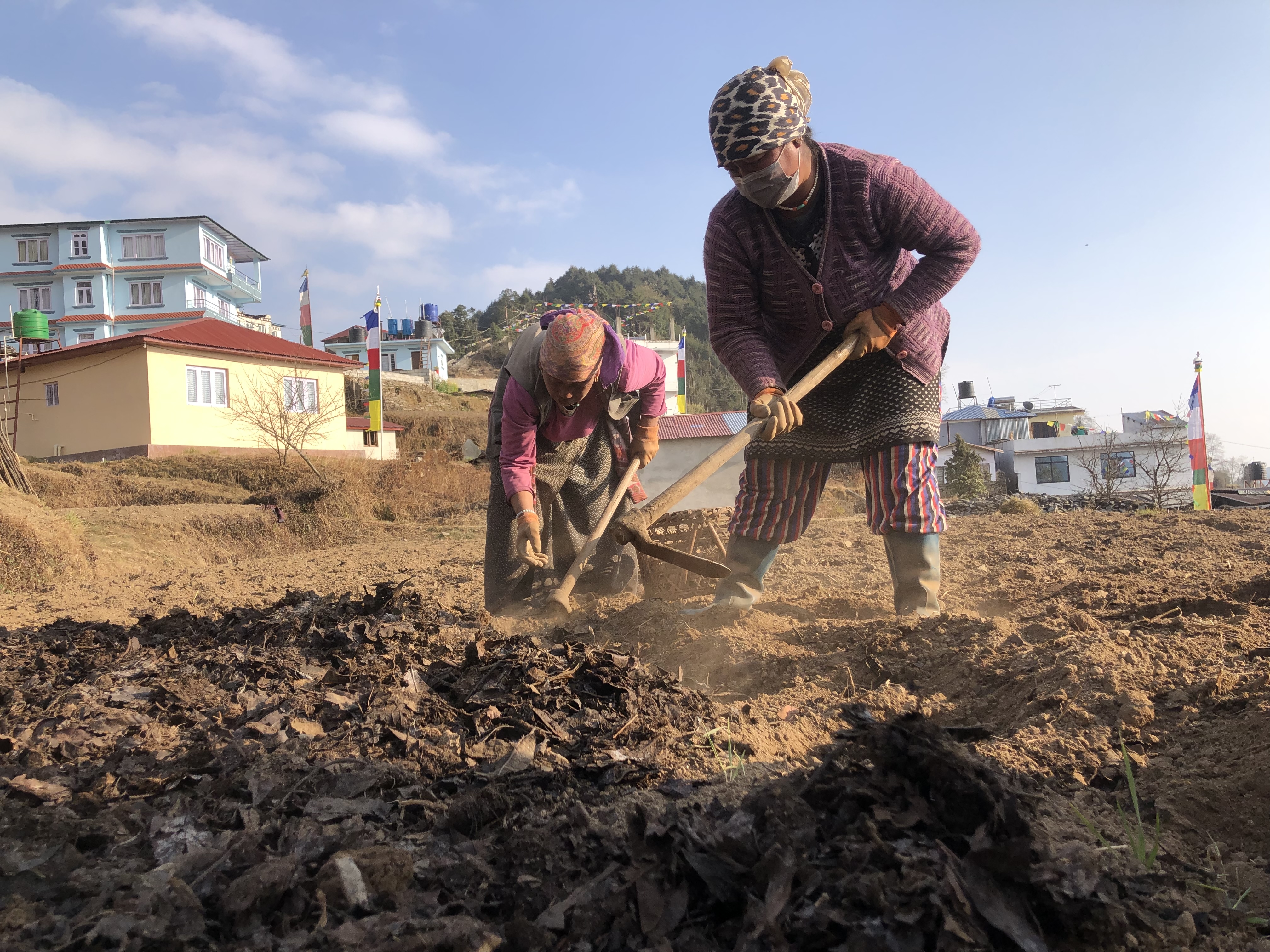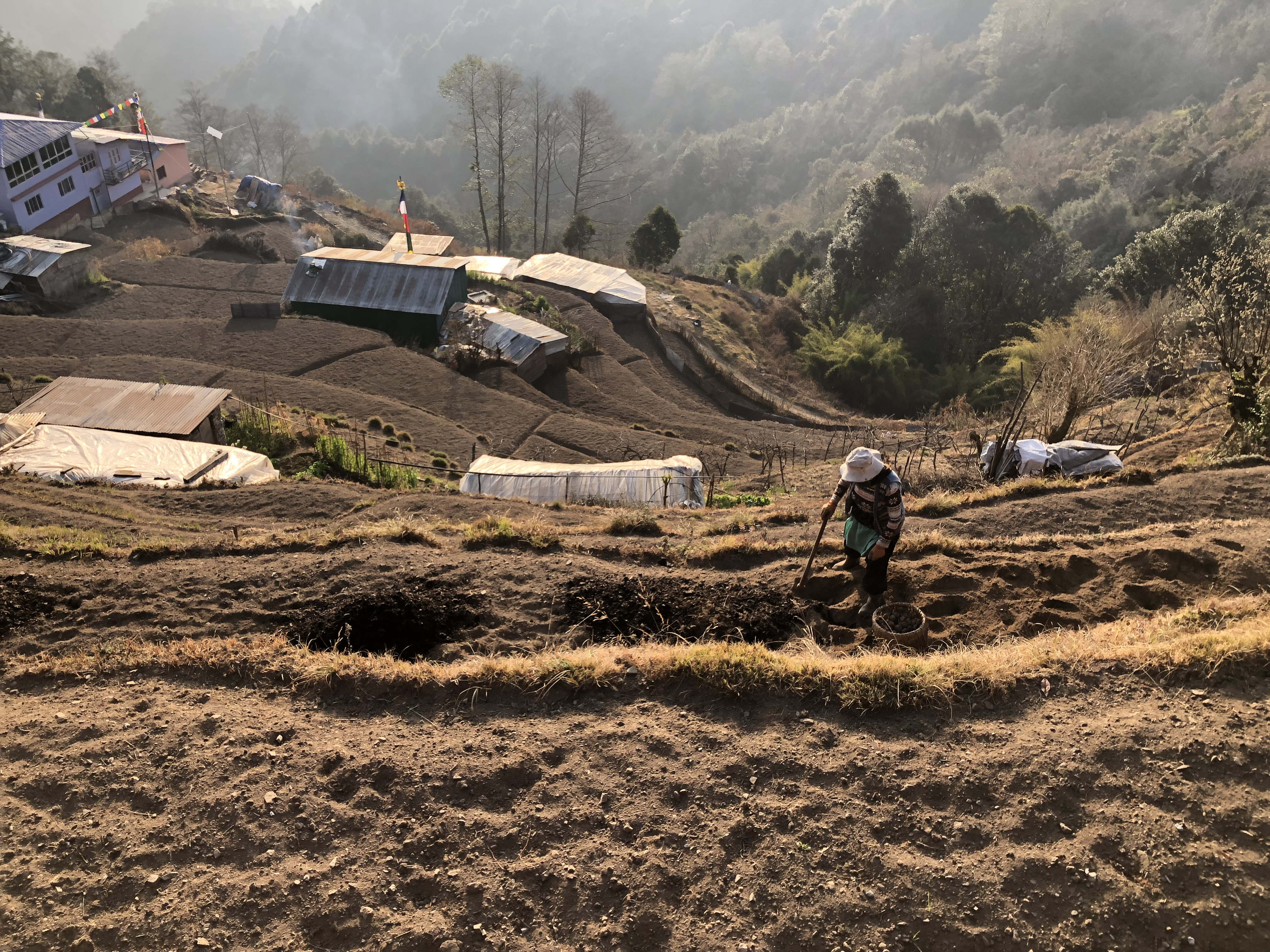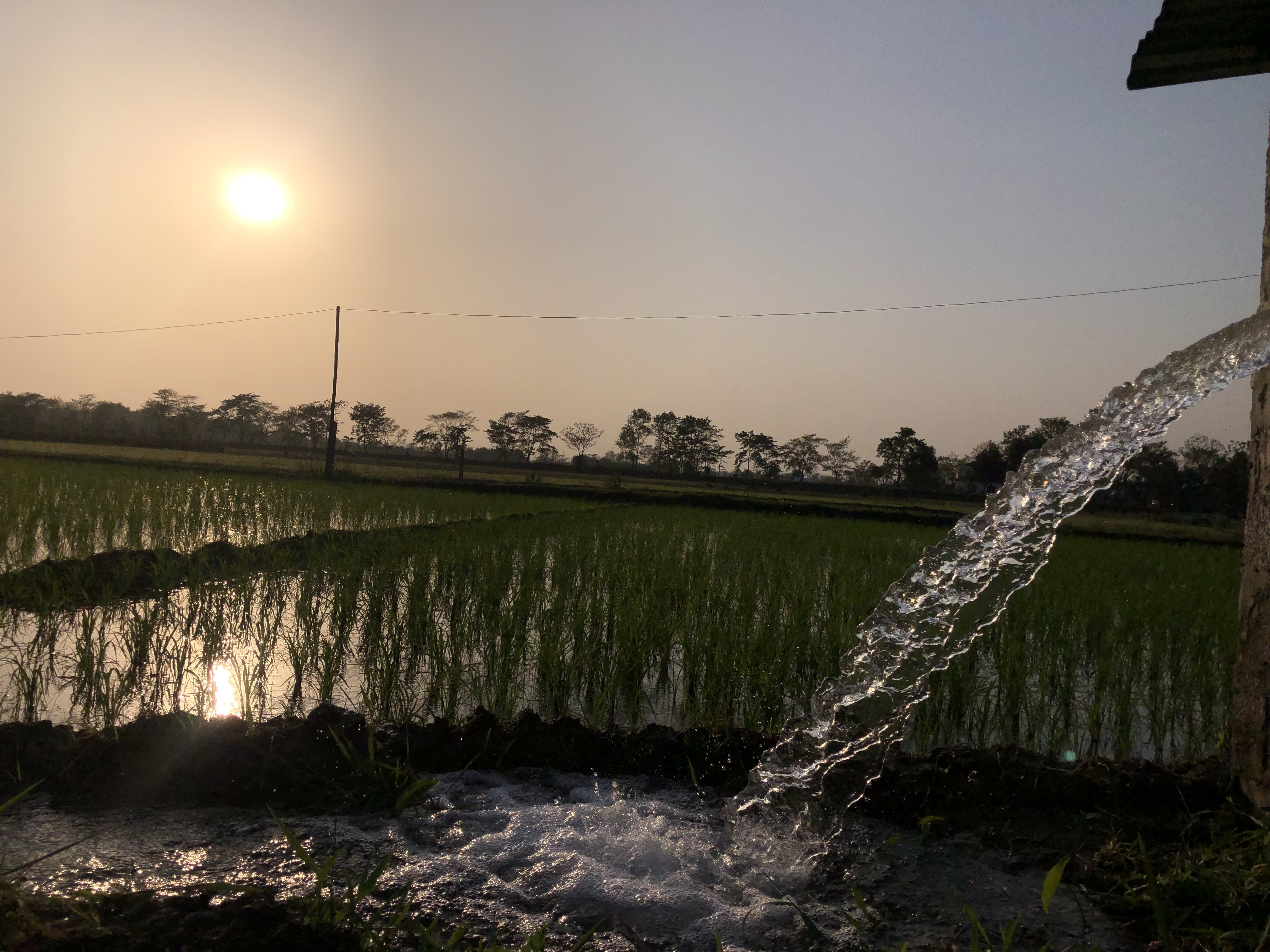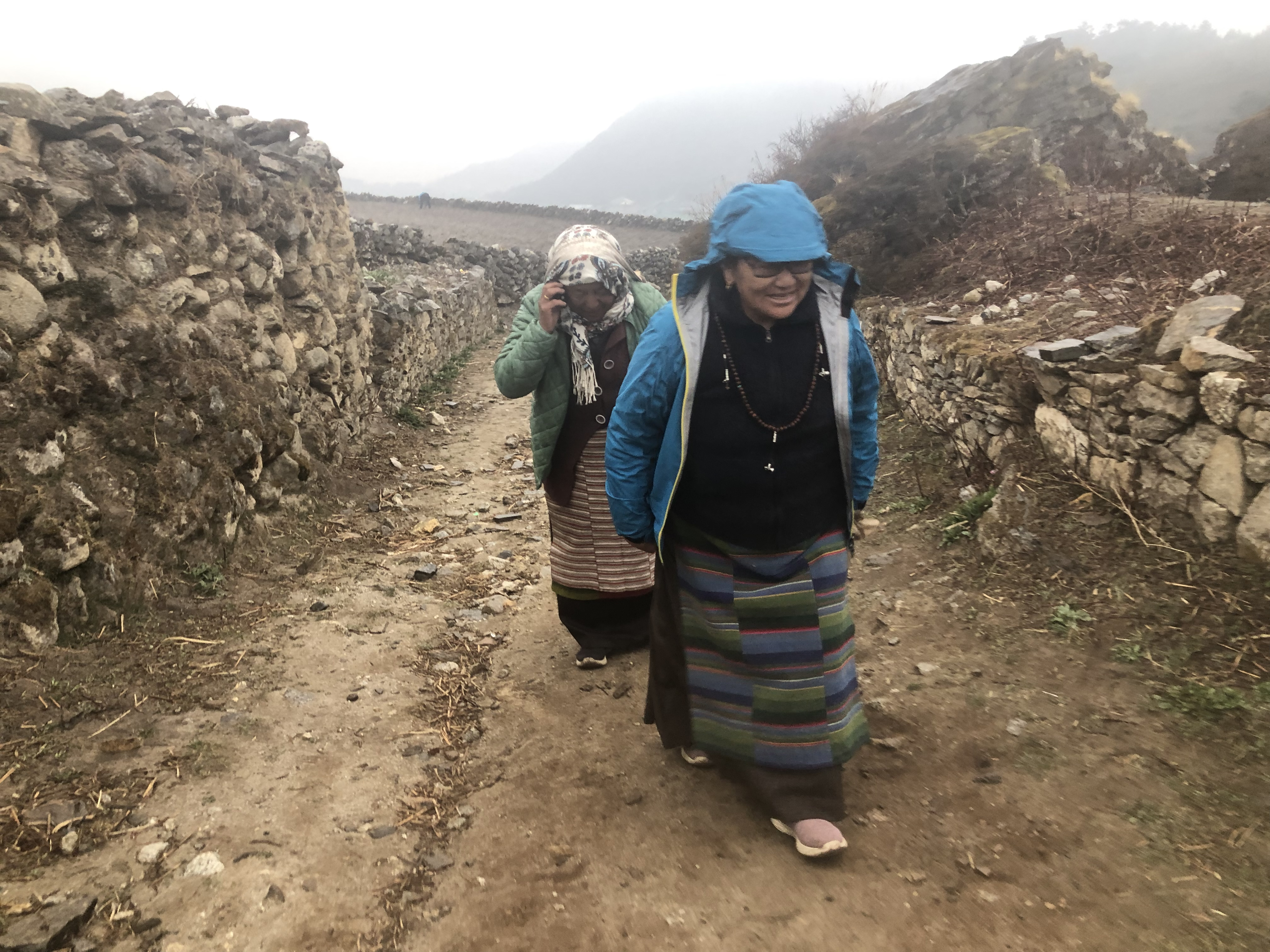
The rays of the sun turned golden in the evening of this past March, yielding a panoramic view of the sky and treeline behind Asramiya Mahato, who was busy picking weeds from her recently planted paddy field. Nearby, water flowed across the green field from a deep boring well. From a distance, it seemed like Mahato was delicately tending to each patch of paddy seedlings. “These planted paddies need care and nurturing,” she said.
After finishing her household chores, she runs to her farm every day. “Without coming here and making sure everything is okay with my plants, I can’t eat,” she said while carefully nurturing the roots of the paddy seedlings she planted about a month ago. “This soil gives us food, and I feel like I have a responsibility to think about it every day.”
At 62 years old, Mahato shared another joy – watching her four-year-old grandson play with mud and soil. “He loves to come here and ‘help’ me, and he says, ‘This is my land!” Mahato, who grew up witnessing many changes in local agricultural practices, reflected, “I know we are not taking care of our soil, which feeds us and gives us life, as well as we take care of ourselves. But seeing another generation growing up connected to this very ground gives me a sense of calm, knowing our soil will be cared for even after I am gone.”
To properly care for the earth, farmers like Mahato need to be aware of the status of their land, and regular testing is essential for this. But, Nepal has only 20 soil and fertility testing laboratories across central, provincial, and university levels—most of which are not easily accessible to farmers.
Challenges

Dr Shree Prashad Bista, Senior Soil Scientist at the National Soil Science Research Center (NSSRC), acknowledged, “We have to accept that these centres are mostly inaccessible to the general public.” NSSRC is a central-level research facility under the Nepal Agricultural Research Council (NARC) dedicated to soil health and management.
However, the centre faces significant challenges due to limited funding, manpower and expertise. “Here at the Center, we have only nine scientists, yet we are responsible for the entire country,” Dr Bista explained the resource constraints they face.
Nepal’s Agricultural Census 2021, published in 2023, highlights a concerning trend: Only 3% of farmers conduct soil tests to assess the condition of their farmland. This is not due to a lack of interest but rather limited access to testing centres across the country.
Even though she has not tested her soil, Mahato nurtures her fields with the same dedication every day, at the same time she thinks “This land will be exploited even more in coming years.”
Neglected soil

The story is the same for Ang Pashang Sherpa in Khumjung village, in the Mt Everest region of eastern Nepal, far from the flat lands of Meghauli, Chitwan. In early May of this year, there was a drizzle in Khumjung. Ang Pashang, 69 years old, was walking with her friend, carrying buckwheat flour they had ground at a nearby watermill.
“Finally, it’s raining!” Ang Pashang exclaimed to her friend. As they walked home, they discussed how, in recent years, the lack of sufficient snowfall and timely rainfall had affected their agricultural practices and productivity.
Despite Nepal ratifying the United Nations Convention to Combat Desertification (UNCCD) 27 years ago, committing to land degradation neutrality by 2030, efforts to prioritise soil health and combat land degradation remain insufficient.
Globally, soil degradation is a major issue. According to a 2022 United Nations report, up to 40% of all soils worldwide are moderately or severely degraded. If harmful practices like intensive cultivation, overgrazing, deforestation, urbanisation, and excessive use of chemical fertilisers and pesticides continue, 90% of the world’s soils could be degraded by 2050.
“Soil is like us – it’s our mother – it feeds us and gives us shelter,” Ang Pashang expressed with gratitude. “But the changing weather patterns are impacting our lifeline, and we’re not caring for it the way it has cared for us over the years.”
She compared herself to the soil, saying, “I am a mother, a grandmother, and if I get sick or need care, my children take me to the hospital. I’ve visited hospitals in Kathmandu for better treatment. But our mother” –she looked toward the farm fields – “never gets that chance.”

Ang Pashang continued, “If there was a hospital for soil nearby, I would check its health regularly. I can feel it changing and in need of extra care, but I don’t know how to find out what’s really going on with it.”
In Meghauli, Mahato uses chemical fertilizers, but in Khumjung, Ang Pashang relies only on compost. Yet, they share the same concern; their source of life – the soil – is going through a difficult time, and they do not have access to soil testing centres.
Soil centres in crisis

While the need is growing, institutes like the NSSRC are struggling. “We don’t have enough manpower, and we don’t have the budget either,” Dr Bista said. For the fiscal year 2024-25, the NSSRC received only 800,000 Nepali rupees (approximately 6,000 USD) for soil research.
This limited funding and the fact that there are only a few soil testing centres available nationwide shows the significant gap between commitments and support to maintain soil health from the government.
Soil scientists say that soil fertility and productivity are severely impacted in areas where food production is crucial to feeding most of the country’s population.
Dr Bista further explains, citing NSSRC’s soil map, “The Terai-lowland region in southern Nepal, including the Madhesh province, has unhealthy soil for crops, while the Karnali province, where food security is always a concern, has more fertile soil compared to other parts of the country.”
Over the years, the use of compost fertiliser has declined, while dependence on chemical fertilisers and pesticides has increased, affecting soil health. Dr Bista added, “Overuse of land is now almost certain in most regions, and changing weather patterns are also impacting the quality of our soil, ultimately affecting soil productivity.”
His assessment from a scientific perspective reflects concerns shared by farmers like Mahato and Ang Pashang. In Chitwan, Mahato uses chemical fertilisers but without proper consultation. “Without chemical fertiliser, crop production is impossible,” she says.
In the mountain region like Khumjung, farmers only use compost but changing snowfall patterns have affected productivity. However, there is no dedicated study on how changing weather patterns have impacted soil in these regions, or how farmers like Ang Pashang can improve soil quality.
The southern belt of the country is grappling with land fragmentation and extensive degradation in soil health. The main reasons for this include poor soil management and the overuse of chemical fertilisers and pesticides.
Meanwhile, the Himalayan region faces an increasing threat of topsoil loss due to flash floods and debris flow, exacerbating the degradation of agricultural land and posing a threat to food security. However, most of the soil testing centres are in the southern belt and are not able to adequately serve that part of the country.
The hills and mountain regions are almost completely out of reach from extension workers in the area of soil research. Out of 20 soil labs, at least 12 are in the Terai region, while the rest are in the hills and mid-hills. Apart from the NSSRC at the central level, there is an agency under the Ministry of Agriculture and Livestock Development – Central Agricultural Laboratory (CAL) – which runs mobile soil testing vans.

Ramnath Adhikari, Minister for Agriculture and Livestock Development, is aware of the struggles and importance of soil testing. “I know the situation because my background is also connected to farming, but we are trying to make testing facilities accessible to farmers as much as possible,” Adhikari said. “Indeed, soil is not prioritised as it should be, and we are definitely not taking care of the soil. But I am committed to increasing the budget for soil research and testing in the coming fiscal year.” He argues that farmers also need to be careful and aware of the possible ways to care for their land.
Effects on the ground
Despite limited resources, some soil monitoring has been conducted by the national lab, and the results are concerning. The soil is losing organic matter, with more than 66% of it being classified as overly acidic, and overall nutrient levels, especially in the southern belt, are low.
In February 2021, the government of Nepal launched a digital soil map that provides a localised overview of soil conditions, highlighting degradation. For instance, naturally occurring zinc, which is essential for plant growth and development, is deficient in much of the southern belt (the food basket) and mid-hills.
Potassium, another key nutrient that supports plant growth and reproduction, is also depleted, particularly in the Terai region and parts of the hills and mountain areas.
Even though the recent UN report on soil does not specifically address Nepal, it does provide a global perspective. A more Nepal-specific report, published by Tribhuvan University in 2023, suggests that one of the main causes of soil degradation in Nepal is erosion, estimating the soil erosion rate at 25 tons per hectare per year.
Dr Yamuna Ghale, an advocate for soil management and food security, says that soil degradation is a pressing issue for Nepal, one that will affect future generations. “The government is not taking soil management seriously, and there is no dedicated research or documentation,” Ghale said, “A small portion of land is arable, and we are losing it without paying attention.” According to World Bank data, only 14.75 per cent of Nepal’s land is arable.
Dr Bista agrees with Ghale’s concerns, “We are not taking this issue seriously. Every year we are losing productive soil, and we are merely watching it happen. We need to document the changes and expand access to soil testing facilities.”
However, neither farmers like Asramiya Mahato from the plains of Terai and Ang Pashang Sherpa from the mountains have access to testing centres nor are familiar with the “health status” of their earth.
“I am grateful to this soil for allowing me to cultivate and feed my family, but I am saddened that I cannot check its ‘health’ the way my children check mine,” Ang Pashang said, gazing at her recently planted potato field in Khumjung.
________________________________________________________________________________________________________________
This story was produced with support from the Earth Journalism Network for its special report on soils in the Asia Pacific, Ground Truths.


























